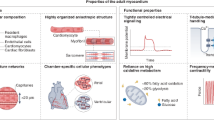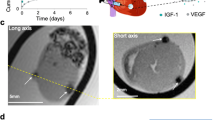Abstract
The past decade has seen the emergence of paradigm shifts in concepts involving cardiovascular tissue regeneration, including the idea that adult stem cells originate in hematopoietic or bone marrow cells, the belief that even adult organs, such as the heart and nervous system, are capable of post-mitotic regeneration, and the concept of inherent plasticity in cells that have undergone limited lineage differentiation. There has consequently been a flurry of proposed regenerative strategies, and safety and limited efficacy data from both animal and limited human trials have been presented. The drive to push these advances from the bench to the bedside has created a unique environment where the therapeutic agents, delivery approaches, and methods of measuring efficacy (often imaging technology) are evolving practically in parallel. The encouraging results of recent cell-therapy trials should therefore be assessed cautiously and in consonance with an understanding of the advantages and limitations of delivery strategies and end points. Arguably, the use of imaging technologies to evaluate surrogate end points might help overcome the difficulty posed by large sample sizes required for hard end point trials in cardiovascular therapeutics. Cardiac magnetic resonance imaging is one of the most sensitive techniques available to assess spatial and temporal changes following local or systemic therapies, and the availability of a bevy of complementary techniques enables interrogation of physiology, morphology, and metabolism in one setting. We contend that cardiac magnetic resonance imaging is ideally suited to assess response to myocardial regeneration therapy and can be exploited to yield valuable insights into the mechanism of action of myocardial regeneration therapies.
This is a preview of subscription content, access via your institution
Access options
Subscribe to this journal
Receive 12 print issues and online access
$209.00 per year
only $17.42 per issue
Buy this article
- Purchase on Springer Link
- Instant access to full article PDF
Prices may be subject to local taxes which are calculated during checkout

Similar content being viewed by others
References
Balsam LB et al. (2004) Haematopoietic stem cells adopt mature haematopoietic fates in ischaemic myocardium. Nature 428: 668–673
Murry CE et al. (2004) Haematopoietic stem cells do not transdifferentiate into cardiac myocytes in myocardial infarcts. Nature 428: 664–668
Rector TS and Cohn JN (1994) Prognosis in congestive heart failure. Annu Rev Med 45: 341–350
Lima JA et al. (1995) Regional heterogeneity of human myocardial infarcts demonstrated by contrast-enhanced MRI. Potential mechanisms. Circulation 92: 1117–1125
Wagner A et al. (2003) Contrast-enhanced MRI and routine single photon emission computed tomography (SPECT) perfusion imaging for detection of subendocardial myocardial infarcts: an imaging study. Lancet 361: 374–379
Klein C et al. (2002) Assessment of myocardial viability with contrast-enhanced magnetic resonance imaging: comparison with positron emission tomography. Circulation 105: 162–167
Kim RJ et al. (2000) The use of contrast-enhanced magnetic resonance imaging to identify reversible myocardial dysfunction. N Engl J Med 343: 1445–1453
Selvanayagam JB et al. (2004) Value of delayed-enhancement cardiovascular magnetic resonance imaging in predicting myocardial viability after surgical revascularization. Circulation 110: 1535–1541
Bello D et al. (2003) Gadolinium cardiovascular magnetic resonance predicts reversible myocardial dysfunction and remodeling in patients with heart failure undergoing β-blocker therapy. Circulation 108: 1945–1953
Britten MB et al. (2003) Infarct remodeling after intracoronary progenitor cell treatment in patients with acute myocardial infarction (TOPCARE-AMI): mechanistic insights from serial contrast-enhanced magnetic resonance imaging. Circulation 108: 2212–2218
Cwajg JM et al. (2000) End-diastolic wall thickness as a predictor of recovery of function in myocardial hibernation: relation to rest-redistribution T1-201 tomography and dobutamine stress echocardiography. J Am Coll Cardiol 35: 1152–1161
Kim RJ and Shah DJ (2004) Fundamental concepts in myocardial viability assessment revisited: when knowing how much is “alive” is not enough. Heart 90: 137–140
Baumgartner H et al. (1998) Assessment of myocardial viability by dobutamine echocardiography, positron emission tomography and thallium-201 SPECT: correlation with histopathology in explanted hearts. J Am Coll Cardiol 32: 1701–1708
Hombach V et al. (2005) Sequelae of acute myocardial infarction regarding cardiac structure and function and their prognostic significance as assessed by magnetic resonance imaging. Eur Heart J 26: 549–557
Kim RJ and Manning WJ (2004) Viability assessment by delayed enhancement cardiovascular magnetic resonance: will low-dose dobutamine dull the shine? Circulation 109: 2476–1479
Vallee JP et al. (1999) Quantification of myocardial perfusion with FAST sequence and Gd bolus in patients with normal cardiac function. J Magn Reson Imaging 9: 197–203
Simons M et al. (2000) Clinical trials in coronary angiogenesis: issues, problems, consensus: An expert panel summary. Circulation 102: E73–E86
Neubauer S et al. (1997) Myocardial phosphocreatine-to-ATP ratio is a predictor of mortality in patients with dilated cardiomyopathy. Circulation 96: 2190–2196
Wacker CM et al. (2003) Susceptibility-sensitive magnetic resonance imaging detects human myocardium supplied by a stenotic coronary artery without a contrast agent. J Am Coll Cardiol 41: 834–840
Assmus B et al. (2002) Transplantation of Progenitor Cells and Regeneration Enhancement in Acute Myocardial Infarction (TOPCARE-AMI). Circulation 106: 3009–3017
Strauer BE et al. (2002) Repair of infarcted myocardium by autologous intracoronary mononuclear bone marrow cell transplantation in humans. Circulation 106: 1913–1918
Perin EC et al. (2003) Transendocardial, autologous bone marrow cell transplantation for severe, chronic ischemic heart failure. Circulation 107: 2294–2302
Kang HJ et al. (2004) Effects of intracoronary infusion of peripheral blood stem-cells mobilised with granulocyte-colony stimulating factor on left ventricular systolic function and restenosis after coronary stenting in myocardial infarction: the MAGIC cell randomised clinical trial. Lancet 363: 751–756
Wollert KC et al. (2004) Intracoronary autologous bone-marrow cell transfer after myocardial infarction: the BOOST randomised controlled clinical trial. Lancet 364: 141–148
Fernández-Avilés F et al. (2004) Experimental and clinical regenerative capability of human bone marrow cells after myocardial infarction. Circ Res 95: 742–748
Smits PC et al. (2003) Catheter-based intramyocardial injection of autologous skeletal myoblasts as a primary treatment of ischemic heart failure: clinical experience with six-month follow-up. J Am Coll Cardiol 42: 2063–2069
Menasché P et al. (2003) Autologous skeletal myoblast transplantation for severe postinfarction left ventricular dysfunction. J Am Coll Cardiol 41: 1078–1083
Author information
Authors and Affiliations
Corresponding authors
Ethics declarations
Competing interests
The authors declare no competing financial interests.
Rights and permissions
About this article
Cite this article
Fuster, V., Sanz, J., Viles-Gonzalez, J. et al. The utility of magnetic resonance imaging in cardiac tissue regeneration trials. Nat Rev Cardiol 3 (Suppl 1), S2–S7 (2006). https://doi.org/10.1038/ncpcardio0418
Received:
Accepted:
Issue Date:
DOI: https://doi.org/10.1038/ncpcardio0418
This article is cited by
-
Endpoints in stem cell trials in ischemic heart failure
Stem Cell Research & Therapy (2015)
-
Angiogenic therapy for cardiac repair based on protein delivery systems
Heart Failure Reviews (2012)
-
Imaging Cell Therapy for Myocardial Regeneration
Current Cardiovascular Imaging Reports (2012)
-
Cell delivery and tracking in post-myocardial infarction cardiac stem cell therapy: an introduction for clinical researchers
Heart Failure Reviews (2010)
-
Magnetic resonance assessment of stem cells
Current Cardiovascular Imaging Reports (2009)



